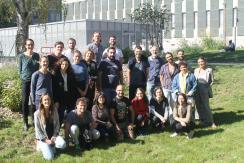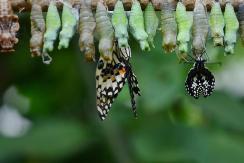COEVOL Multi-Scale Coevolution
Living systems are highly integrated, with a multitude of levels of organization, from molecular and intra-cellular scales to ecosystems. Complex organisms are themselves consortia of macro- and micro-organisms, which work together with their host to build the individual. Yet, each of these organisms can function and evolve in the short term according to its own logic, possibly in conflict with other higher or lower levels, or with other time scales. The once common idea among evolutionists that natural selection results in organisms perfectly adapted to their environment is now severely undermined. Not only because, as the Red Queen explains to Alice, one has to run relentlessly to keep its place in a changing environment, or because past evolutionary history and chance constrain the possibilities of present adaptation, but also because different levels of selection have interests that are generally difficult to reconcile.
Multi-scale coevolution resets classical questions in evolutionary biology
One example, of particular interest is the question of the source of heritable variations. The phenotype of organisms in a population is influenced not only by variations in their nuclear and mitochondrial genomes, the dynamics of which is the object of population genetics, but also more and more patently by the consortium of microbes and genetic elements that constitute its microbiome and virome. The hologenome designates this complex assembly of genetic materials, which obey different rules of transmission and different evolutionary strategies. The ability of symbionts to manipulate host phenotypes or to interfere with each other influences the evolutionary dynamics of all players in ways that are yet poorly understood. In addition, new questions arise, such as the importance of co-adaptation in these systems and their consequences in maintaining cohesive biological systems.
- Symbiosis: a response to and a source of divergent selection
Using a variety of approaches combining experimental evolution, genomic, functional, phenotypic and behavioral data, we aim to test whether symbiosis facilitates diversification and to characterize the underlying microevolutionary processes.
- Ecological networks of horizontal gene transfer
We develop original methods to detect gene transfer and we investigate the factors that influence the routes of gene transfers among microbes but also among insects.
- The interplay between symbiosis, infection and immunity and its evolutionary consequences
We try to understand the intimate interaction of hosts with pathogens, symbionts and transposable elements and how it affects the extended phenotype of the host.
- Transgenerational inheritance and environment changes
We try to decipher the molecular mechanisms that underlie rapid adaptation to environment and to test for transgenerational inheritance of fitness traits.
- Intragenomic conflicts and demography
We are developing models to test whether changes in the demography of the host affect the dynamics of transposable elements.
- The determinism of phenotypic convergence
We study the genomic basis of convergent phenotypic evolution in particular in the case of animals and plants adaptation to increasing temperature and decreasing water.
- Reconciling the tree of life
We develop phylogenetic methods for “reconciling” gene/species or host/symbiont histories and use these methods to explore the bulk of extinct or undescribed species and the history of association of symbiotic microbes with their hosts.
Integrating methods
The methods we use to tackle the questions raised by multi-scale co-evolution extend from theory, modelling and simulation to big data analysis, lab (notably on insects), and to a lesser extent, field activities.
Implication of research, responsibility of researchers and citizen sciences
From our research (some of which have immediate consequences in health, agriculture and ecology) and our concerns about the responsibility of scientists in society, we are committed to promote an “implicative” research. The implicative position means that we try to work on the link between science and society, not only through a one-way communication, applying or explaining our science, but also favoring early discussions on research projects, that may influence our research directions.
Publications
Display of 121 to 150 publications on 709 in total
Phyloformer: towards fast and accurate phylogeny estimation with self-attention networks
Preprint
see the publicationBayesian investigation of SARS-CoV-2-related mortality in France
Peer Community Journal . 2 ( e6 )
Journal article
see the publicationA hapless mathematical contribution to biology
History and Philosophy of the Life Sciences . 44 ( 34 )
Journal article
see the publicationHigh Stability of the Epigenome in Drosophila Interspecific Hybrids
Genome Biology and Evolution . 14 ( 2 )
DOI: 10.1093/gbe/evac024
Journal article
see the publicationThirdkind: displaying phylogenetic encounters beyond 2-level reconciliation
Bioinformatics . 38 ( 8 ) : 2350–2352
Journal article
see the publicationPhylogenetic reconciliation
PLoS Computational Biology . 18 ( 11 ) : e1010621
Journal article
see the publicationSex‐related differences in aging rate are associated with sex chromosome system in amphibians
Evolution - International Journal of Organic Evolution . 76 ( 2 ) : 346-356
DOI: 10.1111/evo.14410
Journal article
see the publicationLong-range promoter–enhancer contacts are conserved during evolution and contribute to gene expression robustness
Genome Research . 32 ( 2 ) : 280-296
Journal article
see the publicationGhost lineages highly influence the interpretation of introgression tests
Systematic Biology . 71 ( 5 ) : 1147–1158
Journal article
see the publicationComparative transcriptomics between Drosophila mojavensis and D. arizonae reveals transgressive gene expression and underexpression of spermatogenesis-related genes in hybrid testes
Scientific Reports . 11 ( 1 ) : 9844
Journal article
see the publicationOxidative and radiation stress induces transposable element transcription in Drosophila melanogaster
Journal of Evolutionary Biology . 34 ( 4 ) : 628-638
DOI: 10.1111/jeb.13762
Journal article
see the publicationTransposable element dynamics in the host-bacteria association of the cereal weevil Sitophilus oryzae
Mobile DNA 2021 .
Poster
see the publicationAuthor Correction: Chromosomal scale assembly of parasitic wasp genome reveals symbiotic virus colonization
Communications Biology . 4
Journal article
see the publicationThe discovery, distribution and diversity of DNA viruses associated with Drosophila melanogaster in Europe
Virus Evolution . 7 ( 1 ) : veab031
DOI: 10.1093/ve/veab031
Journal article
see the publicationComparison of developmental genome expression in rodent molars reveals extensive developmental system drift
Preprint
see the publicationThe Worldwide Invasion of Drosophila suzukii Is Accompanied by a Large Increase of Transposable Element Load and a Small Number of Putatively Adaptive Insertions
Molecular Biology and Evolution . 38 ( 10 ) : 4252-4267
Journal article
see the publicationInfections by Transovarially Transmitted DMelSV in Drosophila Have No Impact on Ovarian Transposable Element Transcripts but Increase Their Amounts in the Soma
Genome Biology and Evolution . 13 ( 9 )
DOI: 10.1093/gbe/evab207
Journal article
see the publicationPhenotypic and Transcriptomic Responses to Stress Differ According to Population Geography in an Invasive Species
Genome Biology and Evolution . 13 ( 9 ) : evab208
DOI: 10.1093/gbe/evab208
Journal article
see the publicationSeaview Version 5: A Multiplatform Software for Multiple Sequence Alignment, Molecular Phylogenetic Analyses, and Tree Reconciliation
Multiple Sequence Alignment . 2231 : 241-260
Book chapter
see the publicationTransposable Element Expression and Regulation Profile in Gonads of Interspecific Hybrids of Drosophila arizonae and Drosophila mojavensis wrigleyi
Cells . 10 ( 12 ) : 3574
Journal article
see the publicationDROP: Molecular voucher database for identification of Drosophila parasitoids
Molecular Ecology Resources .
Journal article
see the publicationA Codon Model for Associating Phenotypic Traits with Altered Selective Patterns of Sequence Evolution
Systematic Biology . 70 ( 3 ) : 608-622
Journal article
see the publicationCytotype Affects the Capability of the Whitefly Bemisia tabaci MED Species To Feed and Oviposit on an Unfavorable Host Plant
mBio . 12 ( 6 ) : 1-16
Journal article
see the publicationWolbachia load variation in Drosophila is more likely caused by drift than by host genetic factors
Peer Community In Evolutionary Biology .
Journal article
see the publicationPredicted effects of summer holidays and seasonality on the SARS-Cov-2 epidemic in France
medRxiv : the preprint server for health sciences .
Preprint
see the publicationRole of symbionts in insects’ ecological diversification: cytotype influences exploitation of an unfavorable host plant in the sap-feeder Bemisia tabaci
DECRYPthèse E2M2 Edition 20 .
Conference paper
see the publicationRole of symbionts in insects’ ecological diversification: cytotype influences exploitation of an unfavorable host plant in the whitefly Bemisia tabaci (Hemiptera: Aleyrodidae)
Webinaires du Groupe Régional de Recherche en Microbiologie des Interactions (G-RREMI) 2021 .
Conference paper
see the publicationThe transposable element-rich genome of the cereal pest Sitophilus oryzae
BMC Biology . 19 ( 1 ) : 241
Journal article
see the publication

